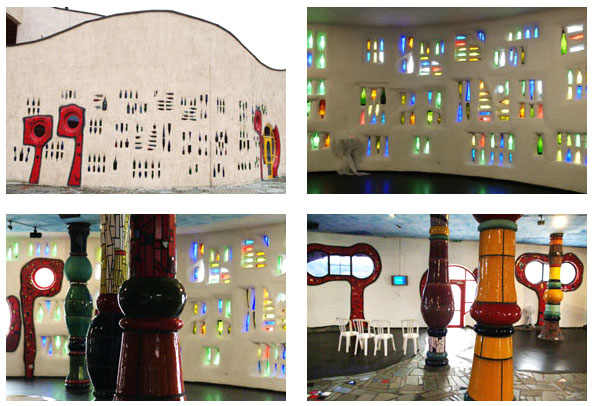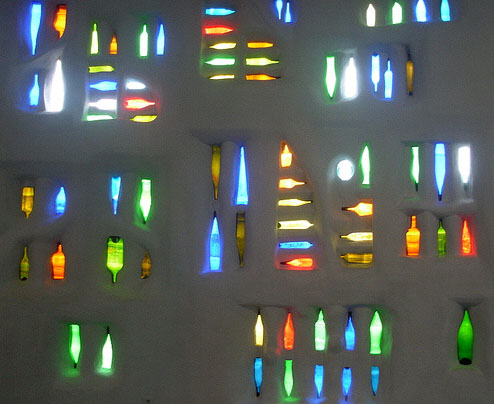March 25, 2007
The Bottle Wall, revisited
I received so many positive responses to the Bottle Wall piece that I thought I would do a brief follow up.
Starting with this amazing photo of the artist Charles Stagg in his home in Vidor, Texas.
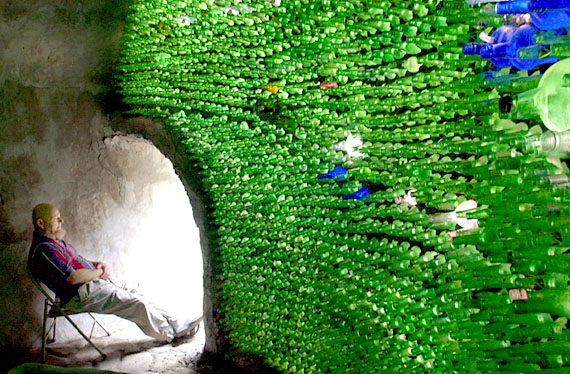
Photo credit to 'Scott Eslinger/The Enterprise July 31, 2005'
Individual Bottle Houses
Charles Stagg's 'A.V. Stagg Art and Wildlife Preserve'
Charlie Stagg is an East Coast educated but Texas born and bred artist who created this house starting in the 1960's. From his home in Texas he has created his artwork and built onto this house for some 40 years.
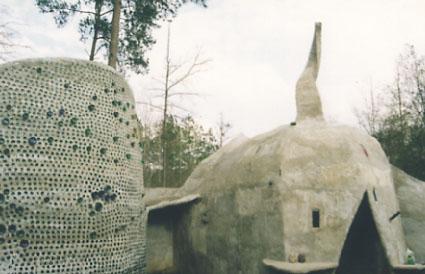
Another take on Charles Stagg can be seen here at narrowlarry's site
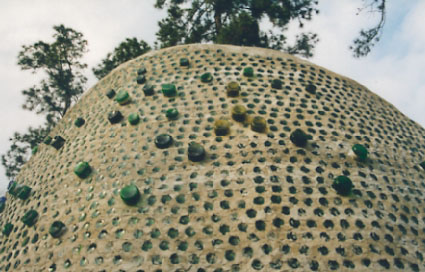
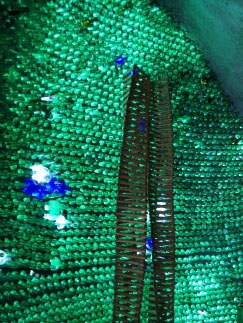
A picture of his studio and his artwork. The studio apparently burned down in 2006, though most of the house remains intact.
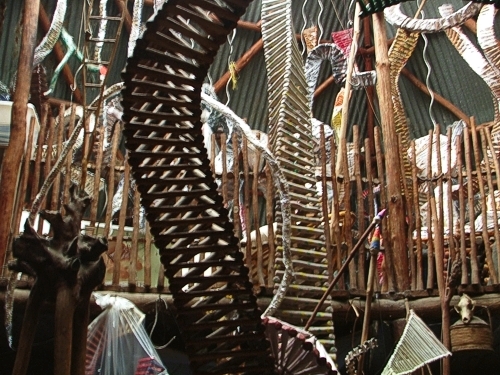
Luna Parc
I received this image of a work-in-progress from Ricky of Luna Parc. Great idea to do all blue bottles. Can't wait to see the finished structure.
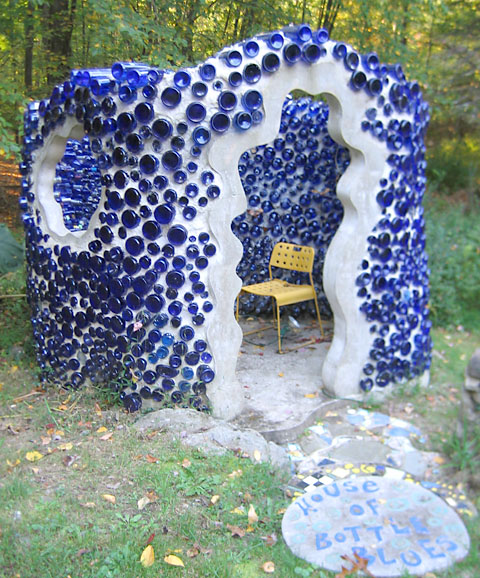
Anna's Bed & Breakfast
This is Anna's Bed and Breakfast near Tucson, Arizona.
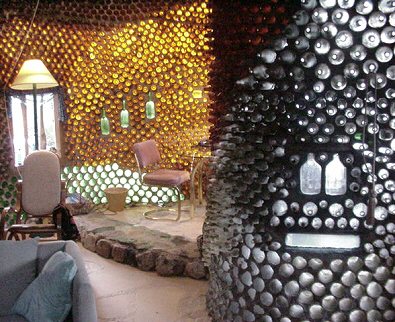
and a part interior, part exterior shot. I like the use of the upright bottles in this one.
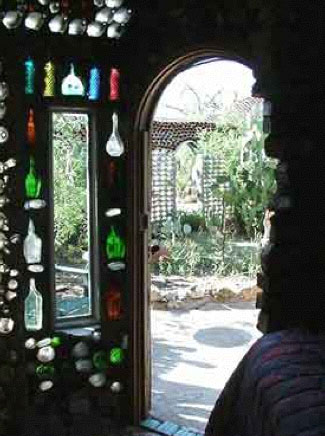
Rockome Gardens
Rockome Gardens is the one of the few places that discriminates as regards the brand of bottle used.
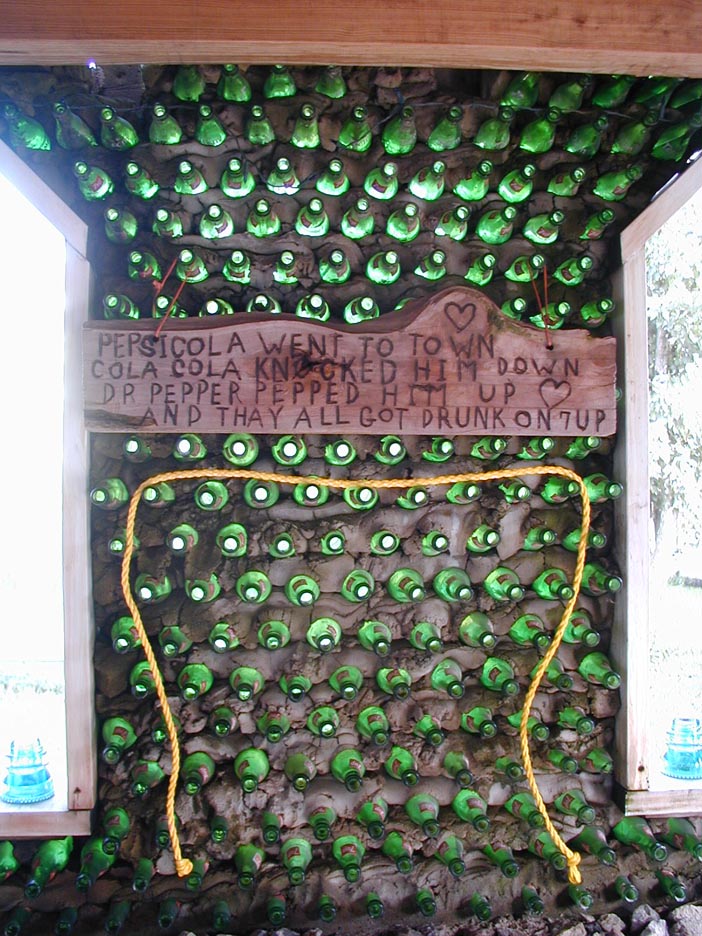
i.e. - these are all Fresca bottles.
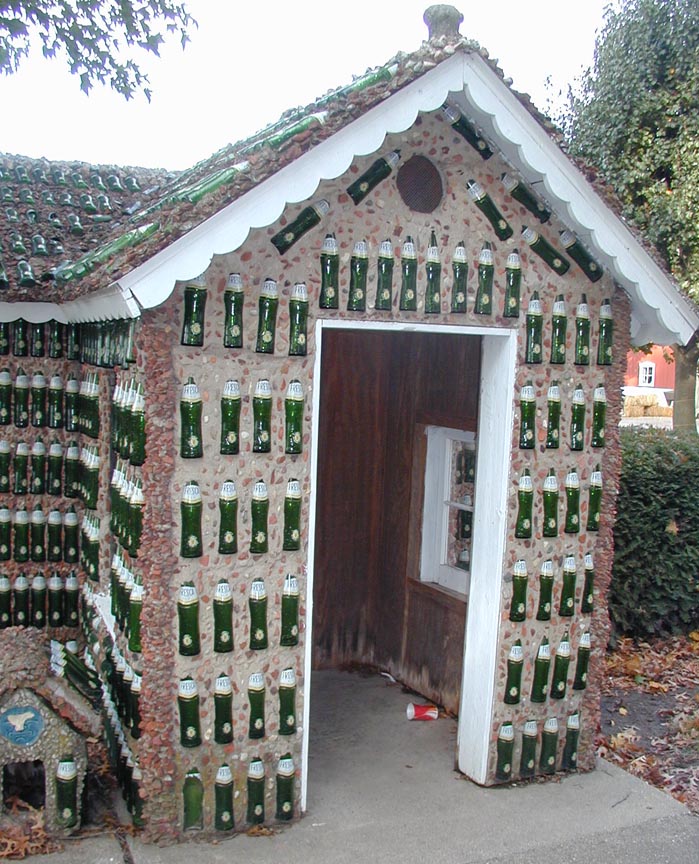
and these are all 7-up bottles.
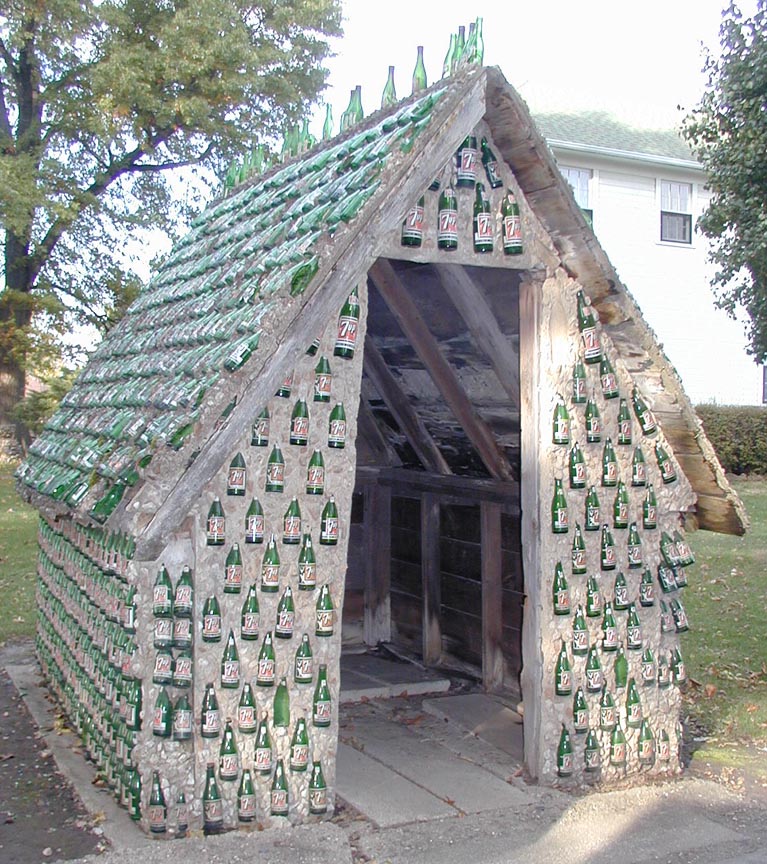
It does make me wonder why the Coca-Cola bottle, with it's distinct shape, has never been used for a bottle wall.
I had intended to put the Rockome bottle houses in the original bottle wall post but thought better of it since, sadly, these structures no longer exist. Acquired by new ownership and not deemed to be a part of their vision for the property (some kind of Amish-themed Park), the new owners demolished the bottle houses in 2006.
Kaleva Bottle House
John Makinen built this bottle house in the 1940's in Kaleva, Michigan with bottles from a local bottling plant. It now houses the Kaleva Historical Museum. I like the incorporated text.
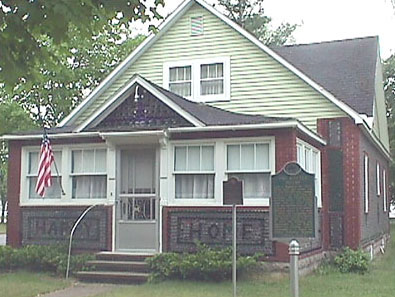
Note the variety of bottles in the closeup -
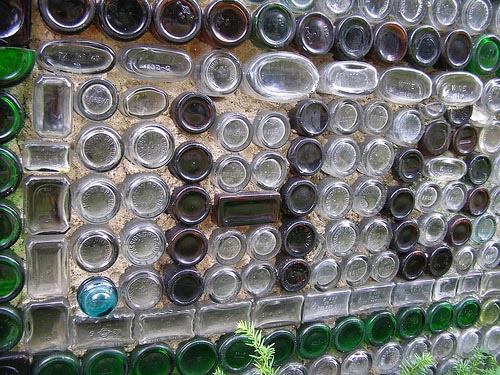
I found the closeup via the amazing and wonderful agilitynut flickr pages. If you like Roadside Attractions (including Bottle Houses), this is the place to go.
The Curious Case of the World Bottle
Like many entries on Wikipedia, the Wikipedia entry on Bottle Wall is as interesting in its omissions as it is in its inclusions, but it's certainly worth a look... and it does mention the Heineken World Bottle, also known as the 'WOBO' or the 'brick bottle'. A quick backstory via Wikipedia -
As the story goes, Alfred Heineken had an epiphany while on a world tour of Heineken factories. When Heineken was on the Caribbean island of Curacao in 1960 he saw many bottles littering the beach due to the fact that the island had no economic means of returning the bottles to the bottling plants from which they had come. He was also concerned with the lack of affordable building materials and the inadequate living conditions plaguing Curacao's lower-class. Envisioning a solution for these problems, he found an architect to design what he called "a brick that holds beer."
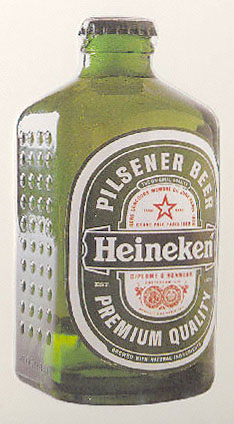
Notice how the bottom of the bottle is recessed so that the neck of the bottle would fit snugly into the bottom.
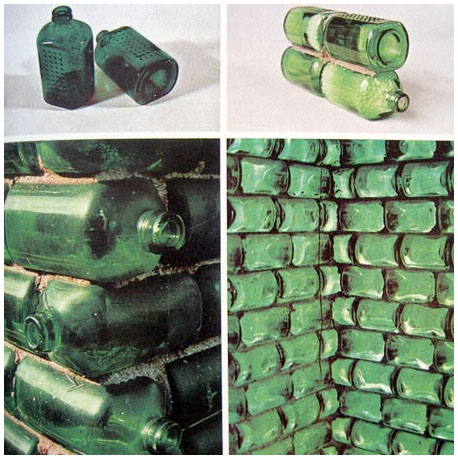
There were apparently 2 sizes, roughly equating to the idea of the brick and the half brick.
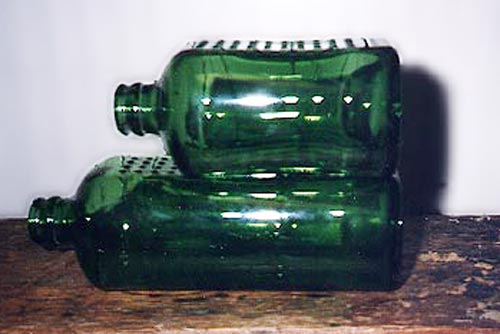
The bottle was designed by Architect John Habraken. They did manufacture the bottle but never released it commercially. Nothing much came of it and there are apparently only one or two existing structures, on the Heineken estate, known to have been made from the bottles. Rumor has it that there are some 60,000 of these bottles in storage somewhere in the Netherlands.
[update feb 2008 - found this Inhabit.com article on the WOBO that includes this image of what is presumably a building with a wall made of WOBO bottles. No further attribution is given.]
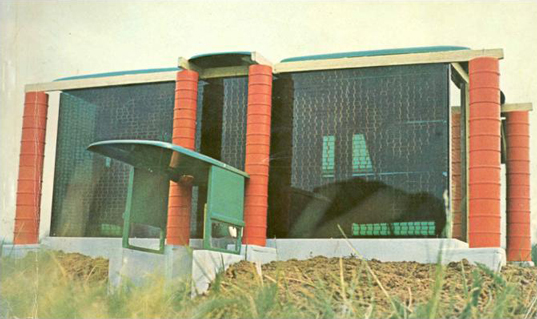
Looking at it I'm not surprised the idea failed. It seems almost an impossible balance - the basic utility of holding beer, balanced with the idea of 'brand identity' as well as the idea of 'sound building material'. Still, it's interesting to see that it went as far as it did and it definitely strikes me as an idea ahead of its time.
How to build a Bottle Wall
I've been asked - are there any resources to let me know how to build a bottle wall? I've searched on the web and so far, no luck. Though I did find this case of a team of people trying to build a bottle wall. Though on close reading it comes off more as how not to build a bottle wall.
March 10, 2007
The Viking Ship at the SLAM
I went this weekend to see the new exhibit called Waking Dreams: The Art of the Pre-Raphaelites from the Delaware Art Museum at the St. Louis Art Museum. I had been anticipating this exhibit mainly because I was curious to see if there was going to be any stained glass incorporated into the exhibit. There is one stained glass panel, designed by Edward Burne-Jones and fabricated by Morris & Co., and it's a good one.
The Viking Ship, 32" x 31.5", 1883-84
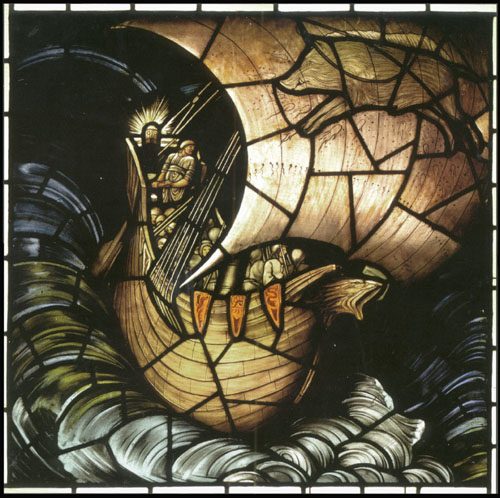
The photo (a scan of the postcard as no photography is allowed at the exhibit) does not begin to do justice to this window. The colors are even more subdued in the real thing. In fact, it is amazing how much is accomplished on what is a very limited color palette. A few shades of tan, and a limited range of blues are all there is. But the richness and dynamic quality is amazing.
There is a substantial use of yellow silverstain used throughout. Any of the greens you see in the water were created by doing the silverstain on blue. The orange on the ship's banners is done with a dark stain. There are bits and pieces of stain throughout the whole piece. I would guess that a good 7o percent of the pieces have at least a touch of stain.
The painting, in particular, is superb, both in line and tone. Note that in the case of his stained glass work, Burne-jones would only have done the design. The painting, fabrication and, in large part, the color selection was done by Morris & Co, with one source crediting the glass painting to John Henry Dearle. There is one cartoon by Burne-Jones at the exhibit and there is surprisingly little detail in the design, only a roughly drawn figure with no background detail at all. I have seen other Burne-Jones cartoons that are more detailed, but those may have been at later stages, as apparently Burne-Jones mainly drew the figures and others drew in the rest.
Some closer views
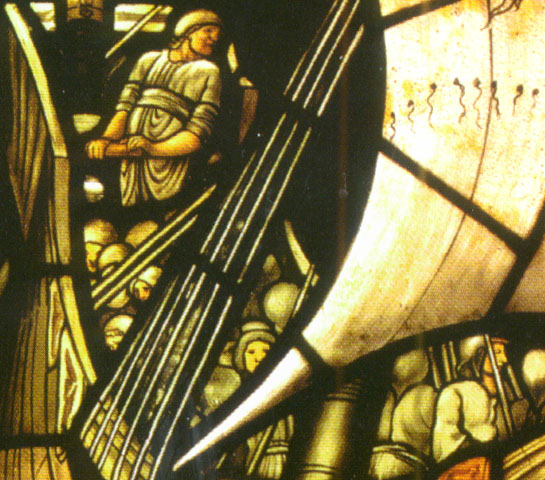
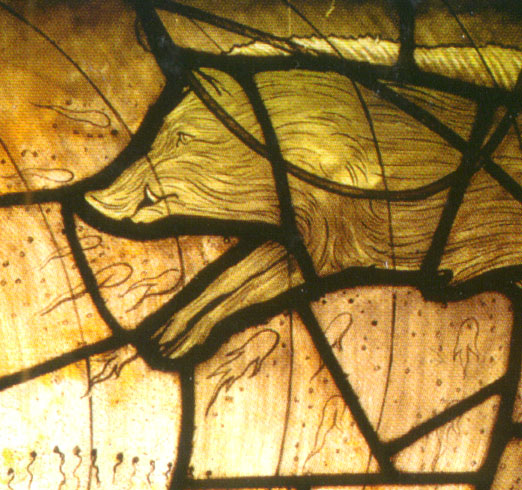
More information on this panel can be seen at this docent page on the Delware Art Museum website.
The panel was created for a residence in Newport, Rhode Island, USA called "Vinland", and was part of a group of nine panels in three rows of three panels, the viking ship being top row center. There is a small picture in the exibition book showing a sketch for the entire program. The lower six windows featured figures from Nordic legends. Curiously, I could find no mention in the exhibition book or on the web as to what happened to the rest of the window.
I did find this cartoon of another section of the window - of Freya. The wikipedia article on Freya states that "she was a goddess of love, beauty, sex, and attraction. Freyja was also a goddess of war, death, magic, prophecies and wealth." Whew, I guess that's why she looks so tired. Note the boar, corresponding with the boar on the sail of the ship. His name is Hildisvini, which means 'battle swine'.
Sketch from the Birmingham Museum of Art -
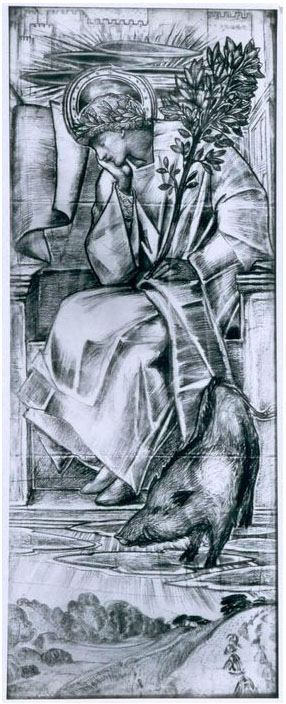
You can download the ipod tour on the SLAM website, or you can go to this introduction page that links to six excerpts from the ipod tour, including one specifically for 'The Viking Ship'.
A nice feature, though the ipod tour is not terribly informative, especially in terms of the stained glass. The Delaware Art Museum Pre-Raphaelite docent pages have much more information.
March 03, 2007
The Bottle Wall
Introducing the Bottle Wall, a peculiar form of stained glass. You won't see any mention of bottle walls or bottle houses in the stately and academic tomes of stained glass history. But stained glass it is, and it deserves recognition.
anonymous bottle wall - posted on Flickr
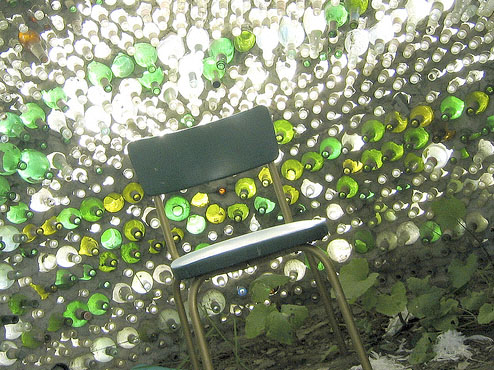
be prepared for lots of pictures...
I became interested in the bottle wall phenomenon most recently through a TV show. Rare Visions & Roadside Revelations is a program exploring outsider art and roadside attractions. It's produced out of Kansas City and so far over 60 shows have been produced in about 10 years. The tone of the show can be fairly described as goofy, but the art that is shown is often amazing and always interesting, and they have visited many sites with bottle walls and bottle houses. So I started researching.
Early History
I don't claim to be an historian, so this will be brief. You will find much more information in the bottle house section of Debra Jane's website on Roadside Attractions.
Bottle houses began as a practical necessity. In remote mining towns where building materials were scarce, someone got the idea of using bottles as a material for building the walls of a house. Such was the case with one of the most famous early Bottle Houses, the Kelly Bottle House in the gold mining town of Rhyolite, Nevada. Because it was located in the desert there were almost no trees, hence no wood. But being a mining town there were 50 bars in close proximity, hence lots of empty bottles.
The Tom Kelly House - Rhyolite, Nevada - circa 1906
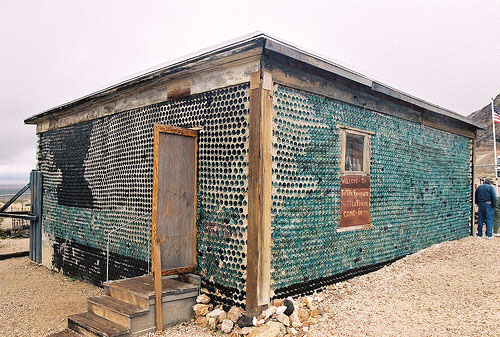
The look of these early bottle houses tended to be more mundane, owing to their utilitarian origins.
By the middle of the 20th century there was a little more 'art' put into the structures and the motivations were more eccentric and personal, such as in this house built as a playhouse.
The Doc Hope House - Hillsville, Virginia, 1941
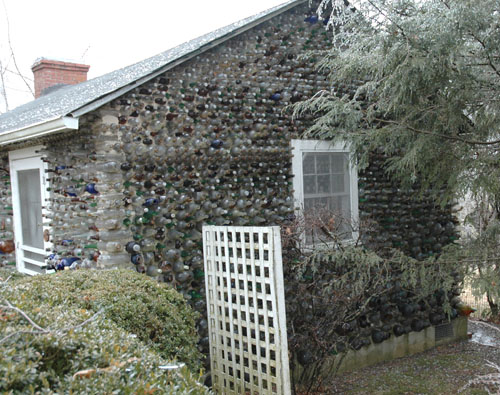
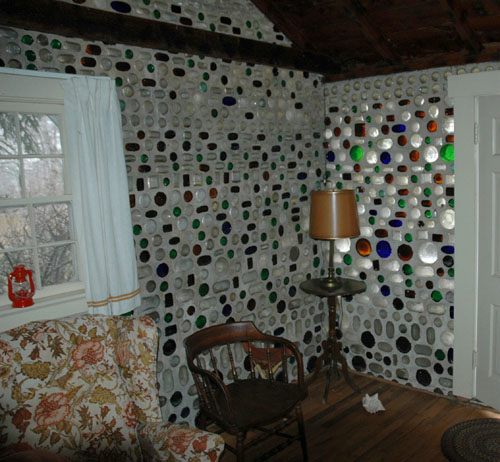
Grandma Prisbrey's Bottle Village
Grandma Prisbrey's Bottle Village in Simi Valley, California was created from 1956 to 1980 and features a series of 13 sheds and other small structures on a small lot of land in Simi Valley, California. Though she originally made these structures to house her collection of pencils (17,000 of them!), Grandma Prisbrey really went wild with Bottle Village, well beyond utility.
For many more pictures check these out -
Flickr set on Bottle Village by Babsomatic
Flickr set on Bottle Village by gldyas
Exterior
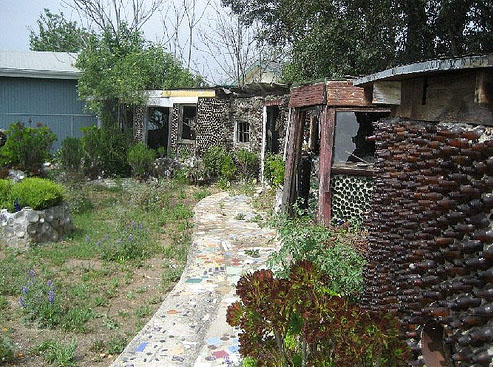
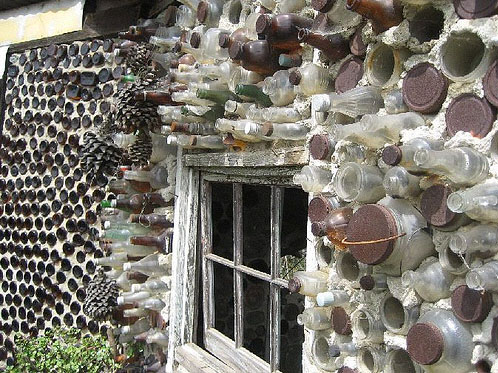
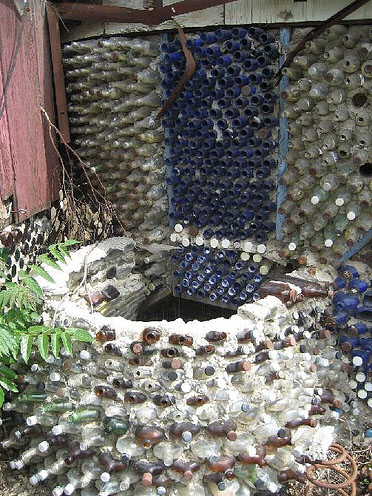
interior of the round house
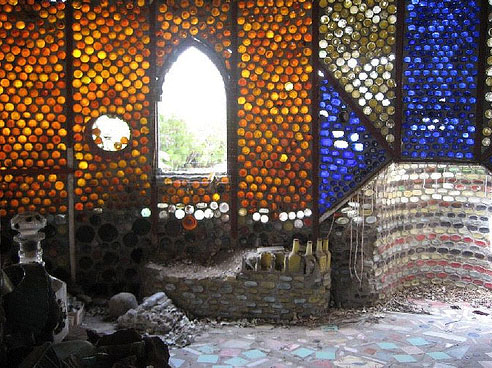
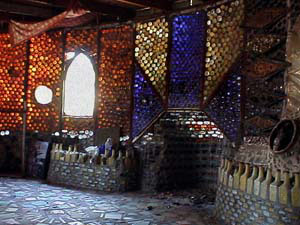
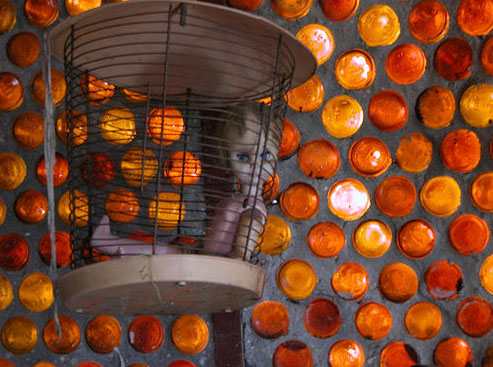
She also had a collection of dolls. Note the beverage tab decoration of the dress.
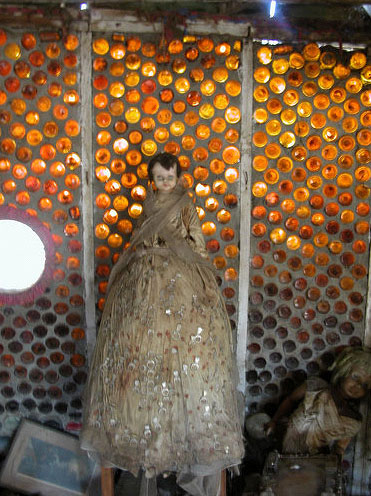
Sadly, much of Bottle Village was destroyed in an earthquake in 1994 and its future remains uncertain.
Tinkertown
Grandma Prisbrey directly inspired other people to create their own bottle houses. Ross Ward was one who saw Bottle Village in the 60's and then went on to create Tinkertown near Albuquerque, New Mexico. The buildings house a museum of his handcarved figures and animated scenes.
Flickr set of Tinkertown by kasiahalka
Exterior of Tinkertown

In amidst the walls of Tinkertown -
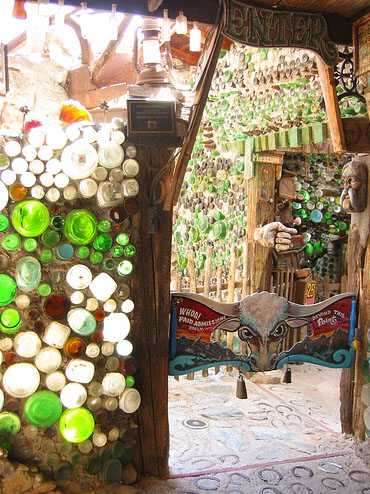
Closeup of a Tinkertown wall highlighting Ross Ward's motto...
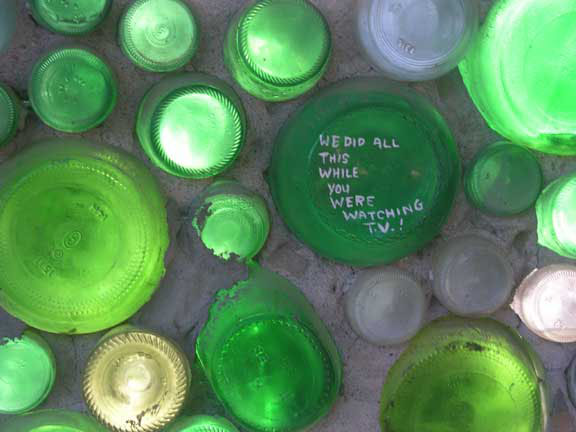
Variety of Styles
A sampling of mostly American and mostly anonymous bottle walls.
Locations cited only when known,
all gathered from a search for 'bottle wall' at Flickr
Thunder Mountain - Imlay, NV
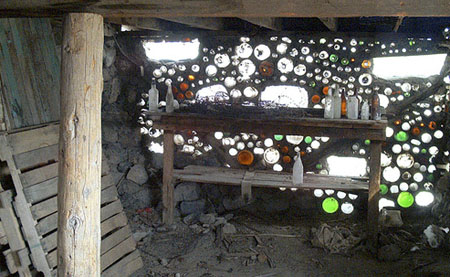
UCM Museum - Lousiana
typical undulating form
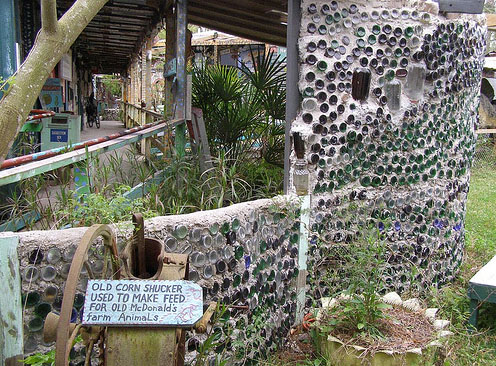
This only said "at a food coop".
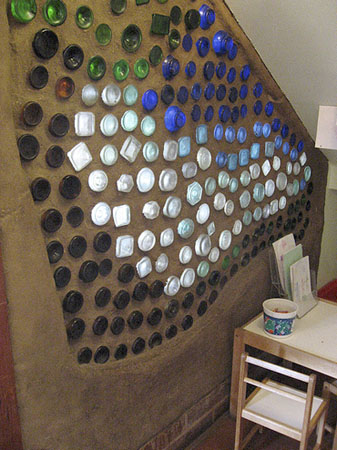
Some have taken to the bottle wall more as an ecological statement on recycling, like this Earthship house near Taos, New Mexico

Another Earthship house.
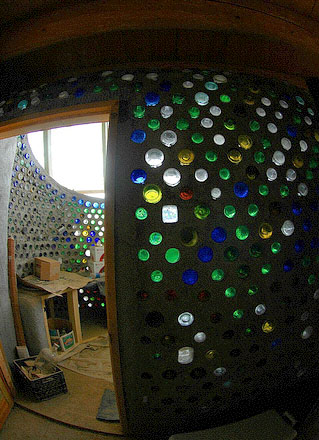
As a small feature in a house, anonymous, in the southwest I would guess.
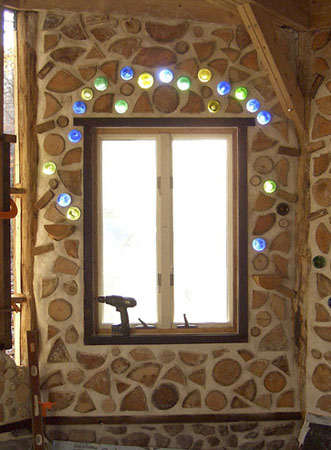
Most bottle walls, especially the garden walls, tend to be rough and messy looking with a kind of improvised mad patchwork quality to them, with no sense of pre-design.
Anonymous American Bottle Wall
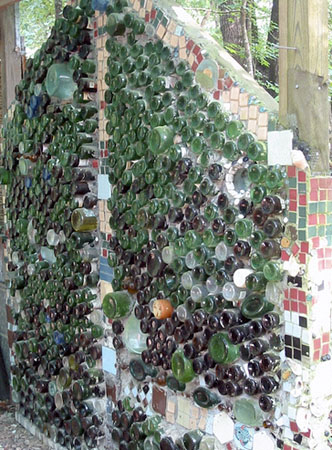
This is another wild one, a wall by an arts center in Deep Ellum in the Dallas area of Texas. I couldn't find the backstory.
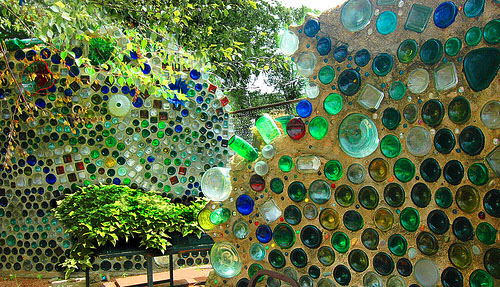
and a close up shot
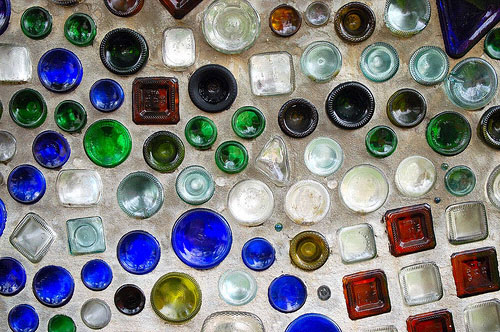
Yet some walls are quite neat and precise. These are often seen in the more commercial or officially public settings, like this from a Napa Valley Winery. The 'neat' walls also tend to forego the use of cement as a matrix for holding the bottles together.
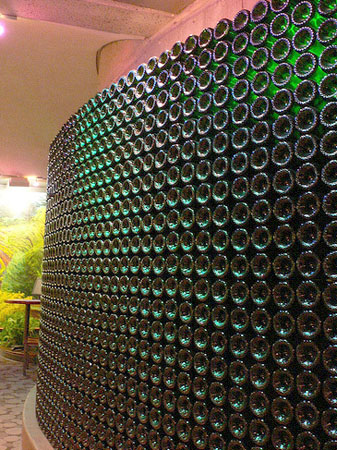
Lightning Ridge
Bottle walls and bottle houses seem to be mostly, but not entirely, an American phenomenon. One striking case outside the USA is in Lightning Ridge, in the outback of Australia. It's an opal mining town that has two bottle house attractions to its credit.
One is the old Bottle House in Lightning Ridge. The standard 'postcard' view -
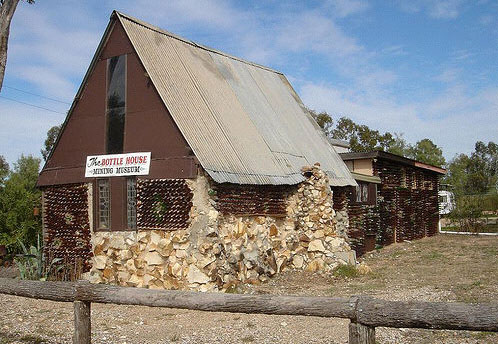
And a closer exterior shot, showing the bottles, which appear to make a specific pattern. The interior seems to be closed, which is pretty common in older bottle houses. Note that there does seem to be some kind of rough pattern going one here.
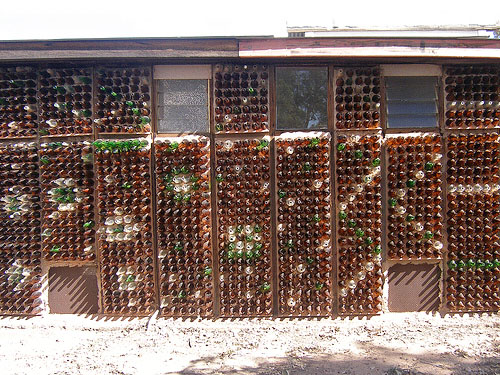
The other site in Lightning Ridge was started in the 70's when John and Joan Andrews created three sandstone cottages incorporating bottle walls. It's now a tourist attraction called Black Queen. The name 'Black Queen' refers to the name of the type of black opal mined in Lightning Ridge.
The most striking feature of the Black Queen Bottle Walls (and the sites say that there are some 34 of them) are the intricately designed patterns.
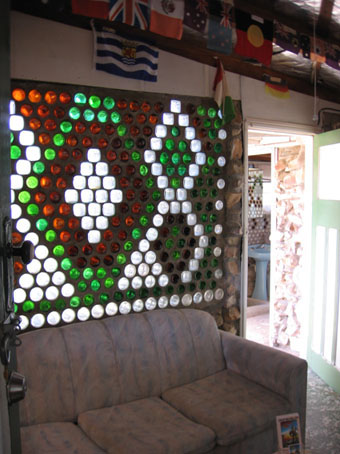
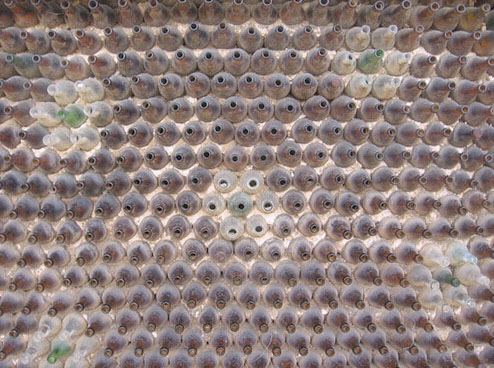
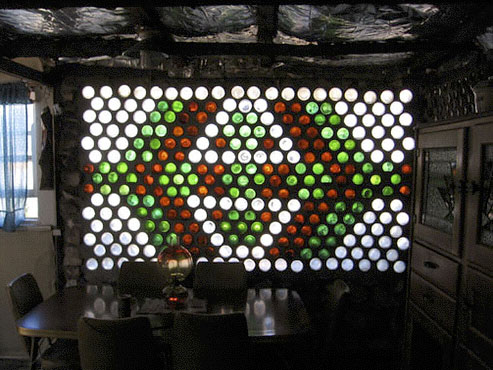
Contemporary Bottle Walls
Zagar's Magic Gardens
Isaiah Zagar in Philadelphia is a muralist who also incorporates bottles into walls. His major creation is the Magic Gardens.
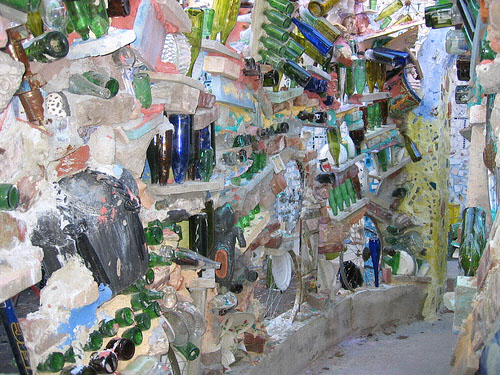
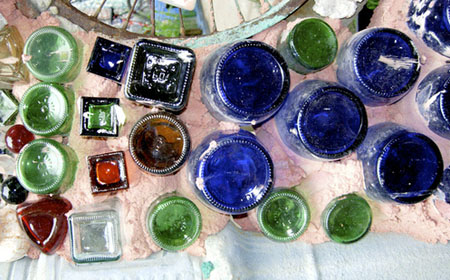
Flickr set of Zagar's Magic gardens by 'Scuzzi'
The Bottle Chapel
One of the more recent and notable bottle walls is The Bottle Chapel at Airlie Gardens near Wilmington, North Carolina. Created as a tribute to Minnie Evans, outsider artist
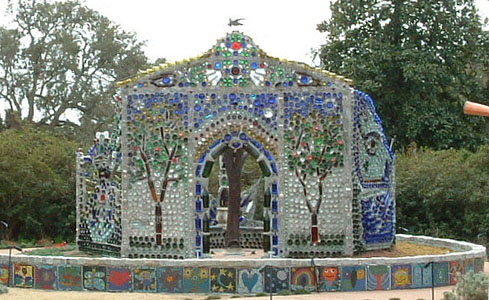
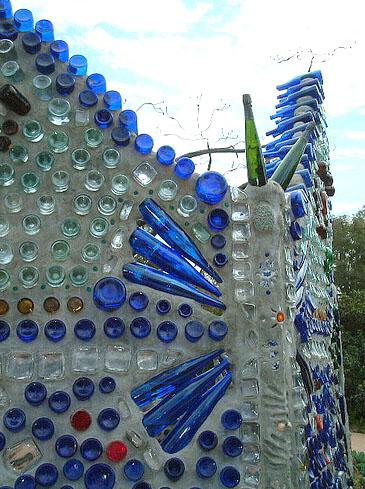
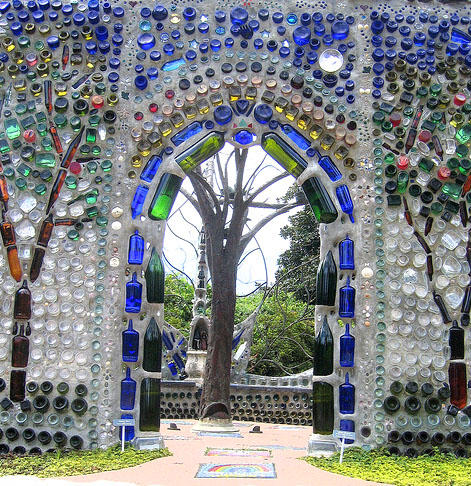
Hundertwasser
Kawakawa Public Toilet
Aptly described as the most photographed toilet in New Zealand, the Kawakawa, New Zealand Public Toilet , built by the Austrian artist and architect Friedensreich Hundertwasser (1928-2000), is a rare instance of a professional architect making a bottle wall. Hundertwasser, at the end of his life, lived in New Zealand and this was among his final projects.
More Hundertwasser architecture images can be seen on the Fickr group called 100wasser.
The street view -
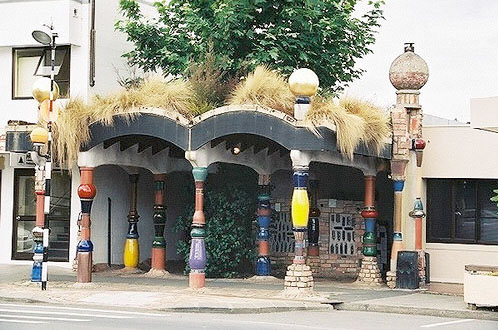
A bit closer -
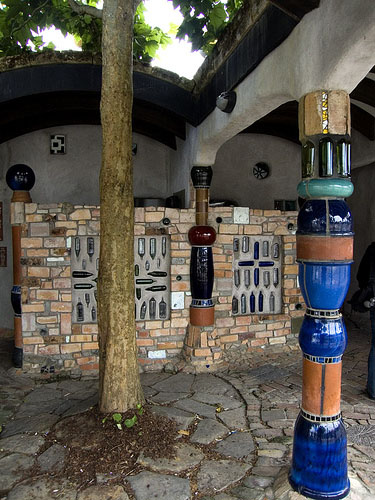
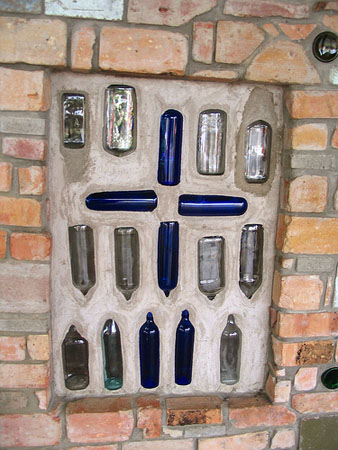
this is the view from the women's room
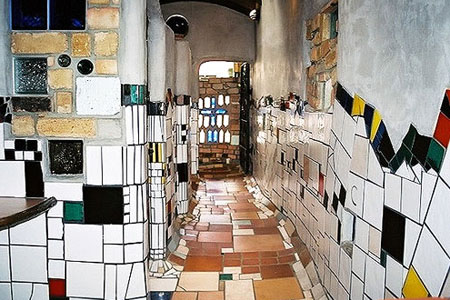
You can believe from these images that Hundertwasser was the man who said "criminal is the use of ruler and T-square in architecture" and "This jungle of straight lines, which is entangling us more and more like inmates in a prison, must be cleared."
this is the view from the men's room
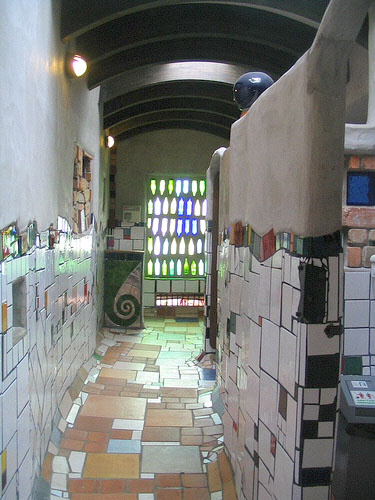
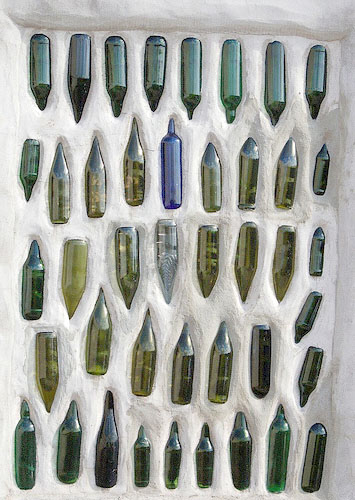
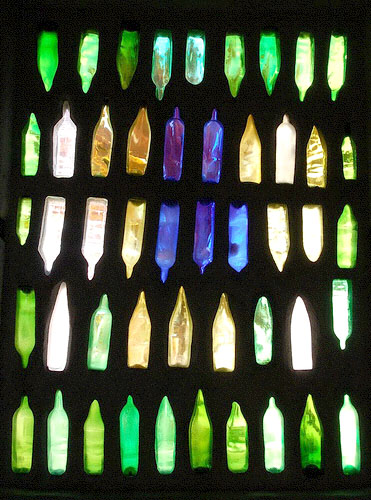
Market Hall, Altenrhein
There is also, finally, this building called the Market Hall in Altenrhein, Switzerland that was done 'in the concept of Hundertwasser' not long after his death in 2000.
Flickr set on Markthalle by 'briethe

